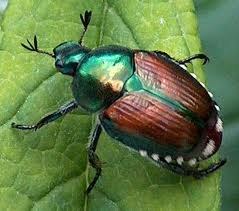They are voracious eaters and will turn a leaf into open lace work. They congregate in droves once they land on a favorite plant. For a month or more they actively feed on trees, shrubs and flowers and, if not controlled, they will “skeletonize” every leaf of the host plant.

I begin patrolling their favorite plants on the first of July: white birch, potentilla, ferns , hydrangea, phlox, astilbe, hibiscus. Predictably, I will spot the first few early arrivals and begin my manual control strategy which I keep up early morning, late evening and on cloudy days, when they are slow moving, until they, almost magically, disappear in mid to late August. This early intervention does two things: it limits the release of an aggregation pheromone which attracts additional adults and decreases the release of sex pheromone by newly emerged females to attract males.
Nature cycles are wonderfully predictable. In our area, the females essentially feed, mate and lay eggs late June to mid-August. They will repeat the feeding, mating, laying cycle until they have laid 40-60 eggs in the soil at a depth of 2-4 inches. By late September the larvae have matured to the grub stage and by October they dig deeper into the soil to overwinter. The grubs move closer to the surface of the soil by mid-April and continue their development into pupae, to emerge as adults, as mentioned above, in late June, early July. And their life cycle begins again.
For management purposes, it's important to recognize that both the grub and the adult stages cause damage. To control the grub population, three options are available. Option 1 is the biological control with bacterial milky spore; option 2 is also biological control with insect parasitic nematodes and the third option is chemical control with insecticides.
To control the adult population, one of the easiest ways is to shake the Japanese beetles into a jar or bucket of soapy water when they are sluggish. Highly valued plants like roses can be protected by covering them with cheesecloth or fine netting. The popular Japanese beetle traps have been found to be less effective, since they attract more beetles that they catch. They can be more effective when spread out over an entire neighborhood, well away from attractive plants. Another method of control is to plant trees and shrubs that are unattractive to beetles. They feed on approximately 300 species of plants, usually those that are in direct sunlight. They seem to love fruit trees, berry plants and vegetable plants, like peas, beans, tomatoes, peppers, asparagus. Some unsavory plants include: elder, red maple, yew, boxwood, dogwood, ash, oak, arborvitae and other ornamental evergreens, begonia, bleeding heart, cornflower, daisy, euonymus, forsythia, lilac, lilies. For areas needing chemical control, many insecticides are labeled for use against adult Japanese beetles.
An infestation of Japanese beetles can do a lot of damage to valuable plants and crops, but one consolation is that their frenzied activity only lasts 4-6 weeks!
By Anna D'Andrea, Master Gardener

